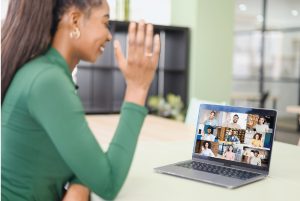
GUEST EDITOR – Matt Barry
Technology can help create togetherness
 We all have a version of the same story: It’s March 2020 and the world is shutting down. We were told that it would take “two weeks to stop the spread.” Some of us gathered up two weeks of supplies (I took a stapler, two pens and a ream of paper), said our see-you later goodbyes, wished for everyone to stay safe and went home.
We all have a version of the same story: It’s March 2020 and the world is shutting down. We were told that it would take “two weeks to stop the spread.” Some of us gathered up two weeks of supplies (I took a stapler, two pens and a ream of paper), said our see-you later goodbyes, wished for everyone to stay safe and went home.
It’s four years later this month, and many of us are still home to some extent, working in a hybrid role and leading teams in absentia.
There’s a belief that being together is a building block of company culture. I’d agree to a point. Company culture can be tied to the amenities that a building offers.
But I found that when I was working from home, it wasn’t necessarily the building I missed (nor the daily commute, which I’m still happy to make only a few times each week). I absolutely miss the hum of a busy office or the opportunity to pop my head over someone’s cubicle wall to ask a quick question. I miss connecting with people; to me, that connection is the core of a company’s culture.
We L&D folk are people-centric, aren’t we?
As a leader, I’m also very aware of the fact that my team misses the same things, and unfortunately for us it’s become a challenge to have more in-person opportunities. As a result, I’ve worked hard to build a remote “office-style” culture for my team, which I’m seeing referred to more and more as a microculture.
It’s a labor of love and one that’s come from leveraging the technology we have on hand to try and replicate togetherness.
Chat Is the New Pop-In
One of the biggest benefits of being in person was the ability to simply stop by someone’s desk or office and ask a question. It was a quick and easy way to engage with one another, and if a door was closed a quick knock let you know if someone was free or not.
In the hybrid world, we’ve replaced this with Microsoft Teams chat. Where a text can be missed or a phone call sent straight to voicemail, a quick “Hi – are you free?” chat pop-up lets any of us respond in the flow of work.
If yes, we can dive right in. If not, we can let the other person know when we will be free, and if warranted, set a time to meet, or simply chat away when that time comes. We’ve leveled up our chats by adding in a follow-on question of “Can I call?” when we have things that are easier to discuss in person than type.
Bringing in Colleagues When Needed
My team has a rule when it comes to chats – if we go more than three replies, the fourth will be “Are you free to talk?” and we convert our discussion to a live one.
The same holds true when we need to bring in colleagues to provide additional context and input. One of us will send a chat to the other, and if they are free, a push of a button adds them to the mix. Not only does this allow us to come together in impromptu ways, but it also enables us to partner together and drive results.
The key word there is “together.” The team feels included, we get a shot to meet in the same way we would when in person, and the work gets done.
Camera’s On and No Questions Asked If Not
The other thing that’s been adopted is that when we get together for a meeting, one-on-one as a team, we all have our cameras on. If we don’t, that’s OK and there’s not an explanation needed. I’m aware that people may not be camera ready at 7:00 a.m., nor do I need to watch someone eat their lunch during a working session at noon.
We’ve grown to love seeing one another’s smiling faces from afar, and some of us are good at spotting changes in appearance or backgrounds. Most importantly, we can read the virtual room and see when someone’s not tracking the discussion, or wants to chime in.
A virtual hand raise is nice, but actually seeing someone raise their hand is fantastic. We’ve leveled up here as well by using PowerPoint Live when presenting– that enables the speaker to still see everyone on camera. Granted the view is limited, but it still helps maintain that connection.
Conclusion
These are just a few ways that my team has embraced working together in a hybrid format.
The idle chit-chat still fills the front part of meetings, and I’m happy to let that continue. We catch up on all kinds of things like kids and movies, and we share in “water cooler” talk about the office as well.
Like I said, I’m a people person. While I can’t be with my people all the time, we’ve built up a way of working that almost feels like we’re together.
 Matt Barry is senior director, learning solutions & global CRM training, for Astellas Pharma US. Email Matt at matt.barry@astellas.com or connect through linkedin.com/in/mattbarry55.
Matt Barry is senior director, learning solutions & global CRM training, for Astellas Pharma US. Email Matt at matt.barry@astellas.com or connect through linkedin.com/in/mattbarry55.








